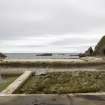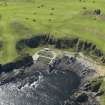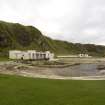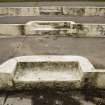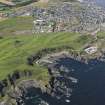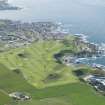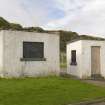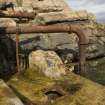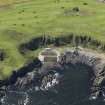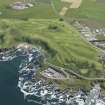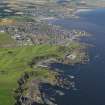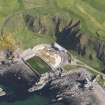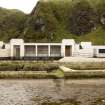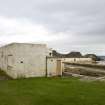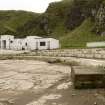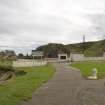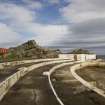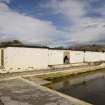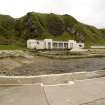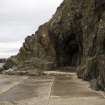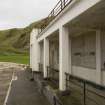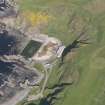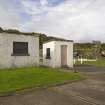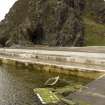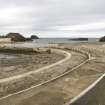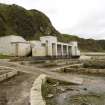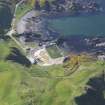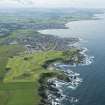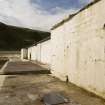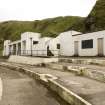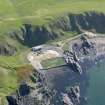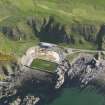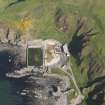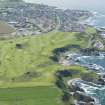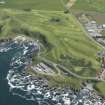Macduff, Tarlair Swimming Pool
Swimming Pool (20th Century)
Site Name Macduff, Tarlair Swimming Pool
Classification Swimming Pool (20th Century)
Alternative Name(s) Loch Craig; Tarlair Swimming Pool Including Boating Pool, Paddling Pool, Tea Pavilion, Changing Rooms, Kiosks And Fence
Canmore ID 292976
Site Number NJ76SW 98
NGR NJ 71982 64661
NGR Description Centred NJ 71982 64661
Datum OSGB36 - NGR
Permalink http://canmore.org.uk/site/292976
- Council Aberdeenshire
- Parish Gamrie
- Former Region Grampian
- Former District Banff And Buchan
- Former County Banffshire
NJ76SW 98 centred 71982 64661
Situated about 1km E of Macduff in what was Loch Craig (Provisional Edition of the 25-inch OS map (Banffshire, c.1915), is a 1930s Art-Deco style concrete open air swimming pool. A single storey tea room with three pools all orignally replenished by the tides. The tea pavilion is situated on the S side with the changing rooms and pay booths on the Western section. The concrete 'terracing' has three levels with steps cut into them at regular intervals and there is a boat ramp to the E of the pavilion. The changing rooms on the W side have cast iron pipes to the sea from the N end. These may have been to supplement the sea water in the pools and would therefore suggest that this end of the building was a pump house.
Two painted signs 'Depth up to 1 metre' survive, one on the changing room and one on the E edge of the swimming pool. Other details include a cast iron handrail at the S end of the changing room where there is a difference in level between the 'terracing' and the entrance. A small niche with concrete step was also noted in the cliff at the NE corner.
The earlier OS 25-inch maps note a 'Shelter' on the W side of Loch Craig.
Visited by RCAHMS (DE, NG), 28 February 2008.
Art Deco tidal swimming pool, boating pool and paddling pool surrounded by curved walkways, with associated tea pavilion at the head of the boating pool. Changing rooms and kiosks to the side. Pool and buildings constructed from concrete.
A remarkably fine, little-altered and early example of an outdoor Art Deco swimming pool. It is one of only 3 known surviving sea-side outdoor swimming pool complexes in Scotland, and certainly the one that best retains its original appearance. The other examples are Stonehaven (1934, listed at category B), which was never tidal, and Gourock, which has been greatly altered and is no longer tidal. Simple tidal pools, such as those at St Andrews and Pittenweem are not included in this category.
The architect of Tarlair pool was John C Miller, the Burgh Surveyor for Macduff. The building of the pool was agreed by the Burgh Council in 1929, and the pool was opened in the summer of 1931. The contractor for the pool was Robert Morrison & Son of Macduff.
Outdoor swimming pools were very popular as social meeting places during the 1930s and a relatively large number of them were built in Scotland, especially at sea-side holiday locations. Built between 1930 and 1931, the pool at Tarlair is one of earliest examples of this sort of swimming pool. The biggest and most impressive pools were at Portobello (1936) and Dunbar (1920s), the latter incorporating not only a swimming pool, boating pool and paddling pool, but also a ballroom in its main pavilion. Other notable pools were located at Arbroath, North Berwick, and Prestwick. These have unfortunately all been demolished (or largely so).
Although the buildings at Tarlair are relatively modest, the pool itself is impressive with the generous curved sides of the boating pool, and swimming pool beyond. The inclusion of a boating pool is particularly unusual; the only other known example was at Dunbar. It also seems to have been relatively unusual for a pool of this scale and level of stylishness to have been tidal. At high tide all parts of the pool are engulfed by the sea. The arrangement of the swimming pool situated to the sea-side the boating pool is practical, as it is obviously more hygienically desirable for the swimming pool to be fully replenished by the sea than the boating pool. Tarlair pool is set in a spectacular location in a rocky bay to the East of Macduff, to which the design of the pool responds well. The pool has been disused since 1995.
A small number of alterations and additions have taken place since it was built (most notably to the paddling pool, and the addition to the tea pavilion), but these alterations are of a superficial nature and its appearance has changed very little since it was photographed in 1935. Its state of intactness, simple yet stylish design, early date and magnificent location all contribute to make this pool the outstanding surviving example of its type in Scotland (Historic Scotland)
Note (October 2017)
Fading Grandeur
Tarlair Swimming Pool is situated in a bay to the east of Macduff on Aberdeenshire’s north coast. It is built in an Art Deco style and opened in 1931 at the height of the outdoor swimming boom. Its popularity continued until the 1970s but with declining visitor numbers and rising maintenance costs, it finally closed in 1995.
The outdoor swimming complex at Tarlair is tucked into the base of the sea cliff at the head of Loch Craig. Constructed out of concrete and painted white, it comprises three pools surrounded by curved walkways, a tea pavilion, changing rooms and kiosks. The three pools include a large swimming pool, located nearest the sea, a paddling pool and a boating pond. All the pools are tidal and are replenished by the sea at high tide, a feature relatively unusual for a pool of this size and scale. The complex was commissioned by Macduff Burgh Council in 1929; designed by John C Miller, the Burgh Surveyor for Macduff; and built by Robert Morrison and Son, a local contractor also from Macduff.
The Outdoor Pool Revolution
During the 1920s and 30s, with rising public awareness of the potential benefits of physical activity and an outdoors lifestyle, scores of new outdoor swimming complexes were constructed across Scotland. As many of these, including Tarlair, were initiated by local councils, their design fell not to architects but to the local burgh engineers and surveyors. This prompted the architect Kenneth Cross to comment somewhat snootily that such swimming complexes were ‘costly and unattractive in appearance’. Nevertheless, the design inspiration of many of the pools owes much to the Piscine Molitor, an Art Deco style indoor pool in Paris designed by the architect Lucien Pollet. Tarlair is an early example of this style.
Like that built at Tarlair, these complexes were much more than places to swim. Many had cafes, sunbathing terraces and viewing galleries. The pools themselves were often venues for diving and swimming competitions as well as aquatic entertainment shows. And for a time, these proved hugely popular - Portobello Open Air Swimming Pool had seating for up to 6000 spectators. Indeed the year before Tarlair closed it played host to a live concert from the Clydebank-based band Wet Wet Wet. A rather fitting name given the venue!
Sadly the shouts and laughter of bathers have long since disappeared at Tarlair and visitors today hear only the roar of the sea and the squawking of gulls. Yet while memories of hot summers and bathing in the pools begin to fade, Tarlair Swimming Pool still stands as testimony to the heyday and spectacle of open air bathing.
Further Reading:
Jane Smith (2005) Liquid Assets: The Lidos and Open Air Swimming Pools of Britain. English Heritage.
Leanne McCafferty - Data Project Manager and Angela R Gannon - Archaeological Field Investigator, Historic Environment Scotland













































